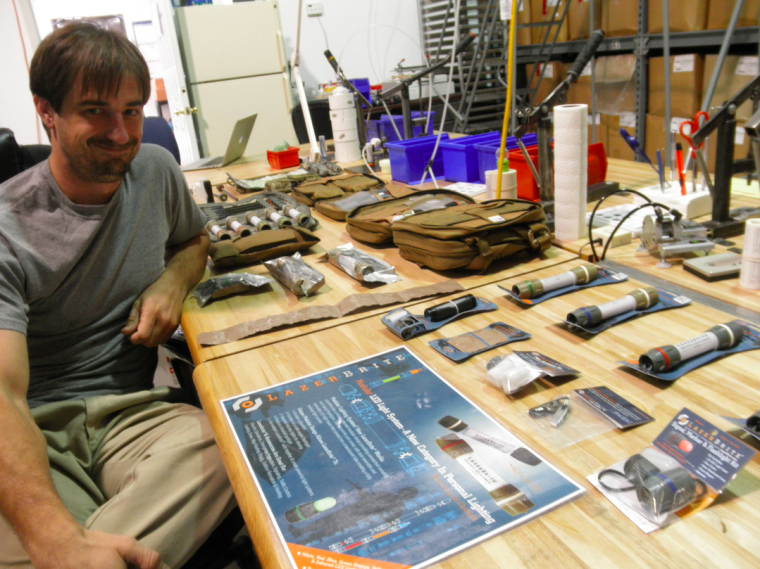Some information may be outdated.
Greg Kennedy has a big dream; he wants to change the way that people look at flashlights.
“If my dreams came true I would change what people expect from a flashlight,” said Kennedy, one of the founders and co-owners of LazerBrite. “I would have people look at a flashlight that just projects forward light and say, ‘is that all it does?’”
Fifteen years ago he and his brother Doug Kennedy invented a light that does far more than just shine light straight ahead.
The brothers opened Gearheads Outdoor Store in Moab in 1998. But because none of the big gear companies would back such a new business, the Kennedy brothers had to get creative and to search for brands that they could carry.
Early on, Kennedy ordered some sample battery operated glow sticks. The day that the lights arrived, after closing, the brothers tested them out.
“We took it into the bathroom, which was the darkest place in there. It was incredibly disappointing because it wasn’t very bright,” Kennedy said. “Then we were sitting there saying we can’t sell these in the store. Then Doug said, ‘I’ll be right back.’”
He came back with a chem light and an LED light. After cutting off the bottom of the chem light and dumping out the contents he stuck the LED inside the tube.
“He turned it on and it was really bright, so much brighter than the (battery operated glow stick). Then we looked at each other and immediately knew this was an idea we really had to pursue,” Kennedy said.
So they did. The basic concept of the light is two LED units screwed into an opaque plastic tube. The LEDs can be reversed to either point out, as a flash light, or into the tube, as a glow stick. The LEDs are available in a variety of colors.
After filing for a patent they hired an engineering firm to design and build the light. There were several design flaws, but some of the groups that saw the light were impressed by the concept.
One of those groups was the military.
“They loved the concept, hated the engineering,” Kennedy said.
The brothers went back to the drawing board to figure out how to fix the flaws.
They did. After a successful vendor show with a prototype of the new model at Modern Day Marine in Quantico, Virg., the military was in.
“That was our first real successful military show. Since ’04 or ’05 we have been solidly at the military,” Kennedy said. “The Army is our biggest customer and the Marine Corps is our second biggest.”
Both have been big customers. The Defense Logistics Agency once put in a stocking warehouse order for 132,000 units.
Since then LazerBrite has come out with a third generation light with a number of improvements, including being waterproof in 50-meter-deep water.
The company has also created a range of kits involving the light, including the lightest landing zone kits and map kits. Several other companies use the lights for the lighting component of their kits.
Many of these improvements and additions came in response to feedback from soldiers.
“We listen to our customers and we react,” said Tom Cooper, the production manager at LazerBrite. “That’s been critical within the military because we talk to all sorts of infantrymen and sergeants and they tell us what they like and what they don’t like.”
Nearly every component in a LazerBrite light is made in America, and the lights are all assembled, packaged, and shipped from here, in Moab.
“Everything we can possibly get made in the U.S.A. is made in the U.S.A.,” Kennedy said. “I’m really happy that we are making the lights here in Moab. We got a great crew that does a good job.”
And though LazerBrite is still focused on the U.S. military, they are now looking at other markets, including retail and foreign militaries. The militaries in Germany, Brazil, and Spain have all expressed interest.
As part of the push into retail LazerBrite, which is still owned by Greg and Doug Kennedy, along with two silent partners, is looking into the possibility of partnering up with a large company with more marketing expertise.
“I see us expanding into even more markets,” Cooper said. “It is absolutely wonderful for outdoor recreation because of its versatility.”
Appreciate the coverage? Help keep local news alive.
Chip in to support the Moab Sun News.


